Unit 2. History. How was the UK created?
Pre-reading task.
Background test. See how many names and phenomena are familiar to you and share your knowledge about them.
ü the Lancastrians,
ü the Yorkists,
ü the Wars of the Roses,
ü Bubonic plague,
ü the Tudors,
ü the Houses,
ü Traitor’s Gate,
ü the Tower,
ü Henry VIII,
ü the Reformation,
ü Anglicanism,
ü Catholicism,
ü The Bill of Rights,
ü Elisabeth I,
ü Sir William Raleigh
Discussion club.
Get in pairs and discuss:
-) Is it possible to build “a better world” by means of revolution?
-) Who do you consider the most important figure in late British history?
Some important facts of the 15th and the 16th centuries.
Split into two teams. Take turns in choosing any familiar word from the word-box below and explaining its meaning to the other team in English. Every correct guess will bring a prize point to a team. For an additional point the one who guesses the word will have to produce a sentence using it.
| rival, to claim, nobles, to challenge, to support, descendants, struggle, shortage, labour, importance, to weaken, ties, to depend, policy, to split, rural, officials, merciless, to oppose, to execute, traitor, reign, doctrine, to demand, adherence, long-reigning, explorer |
Look through the following historic facts and comprise the information in each passage into one sentence.
ü During the 15th century two rival groups claimed the throne of England. The greatest nobles, who had their own private armies challenged the position of the monarch. The Lancastrians, whose symbol was a red rose, supported the descendants of the Duke of Lancaster, and the Yorkists, whose symbol was a white rose, supported the descendants of the Duke of York. The struggle for power led to the Wars of the Roses between 1455 and 1485. They ended when Henry VII defeated and killed Richard III. Then followed an era of stability and strong government.
ü The power of the English monarch increased in this period. Bubonic plague (known in England as the Black Death) killed about a third of the population in the middle of the 14th century and continued to appear periodically for 300 years. The barons were not so strong after the Wars of the Roses, the shortage of labour, the importance of trade in the towns helped to weaken the ties between feudal lord and peasant.
ü The Tudor Dynasty (1485 – 1603) established a system of government departments, that depended on the monarch. As a result, the feudal barons were no longer needed for government policy. Parliament was traditionally split into two Houses. The House of Lords consisted of the feudal aristocracy and the leaders of the Church. The House of Commons consisted of representatives from the towns and the less important landowners in rural areas.
ü Being an important person was not safe in the 16th century. The Tudor monarchs were not loyal to their officials and merciless to any nobles that opposed them. More than half of the famous people of this period were executed as traitors. Few people who were taken through Traitor’s Gate and became prisoners in the Tower of London came out alive.
ü Henry VIII is one of the most well-known monarchs in English history, mostly because he took six wives during his life. It was during his reign that the Reformation took place. His quarrel with Rome had nothing to do with doctrine (it was because he wanted to be free to marry again and to appoint the leaders of the Church of England). In the same decade he had a law passed which demanded complete adherence to Catholic belief. This confession is known as Anglicanism, which was not very different from Catholicism in its organization and ritual.
ü Elisabeth I, daughter of Henry VIII was the 1st of three long-reigning queens in British history. She never married and became known as “the virgin queen”. The area which later became the state of Virginia in the USA was named after her by one of the many English explorers of the time (Sir William Raleigh).
Put a question to each passage and write them down.
Retell the above information in not more than 6 sentences.
Reading. Read the text carefully and retell it close to the original. Be ready to discuss it.
When James I became the first English king of the Stuart dynasty, he was already King of Scotland, so the crowns of the two countries were united. The parliaments and the administrative systems however, were different.
Almost 40 years later The English Civil War broke out. It was part of a wider series of conflicts that involved all the British Isles with Scotland and Ireland as well as England and Wales and is also called "The Great Rebellion", "The English Revolution" and "The Wars of the Three Kingdoms".
It was an armed conflict in the British Isles between Parliamentarians and supporters of the monarchy (Royalists). Tension between Charles I and the House of Commons was growing for some time, and after his unsuccessful attempt to arrest five members of Parliament, both sides prepared for war.
The first phase of the wars (1642-1646) brought victory to the Parliament. In 1647 Charles I asked a Scottish group for assistance, starting the second phase of the wars, a series of Royalist rebellions, and a Scottish invasion. All were defeated, and Charles I was executed in 1649.
The fighting continued, and Royalist forces under Charles II invaded England in 1651. Parliamentary forces defeated the Royalists in 1651 and Charles II ran abroad, ending the civil wars. The wars' political consequence was the establishment of the Commonwealth and Protectorate. The leader of the parliamentary army, Oliver Cromwell became Lord Protector of a republic with a military government. The first attempt was made to unite the three nations under a single government after Oliver Cromwell crushed resistance in Ireland, and the foundations of the modern British constitution were laid.
2 January 1650, every adult male was required to take the Engagement:
"I do declare and promise, that I will be true and faithful to the Commonwealth of England, as it is now established, without a King or House of Lords".
When Cromwell died his system of government became so unpopular that the son of the executed king was asked to return and take the throne. However, the conflict between the monarch and the Parliament soon re-emerged. In the reign of King James II there was a Glorious (bloodless) Revolution in which Prince William, ruler of the Netherlands and his wife Mary Stuart accepted Parliament’s invitation to become king and queen. It was established that a monarch could rule only with the support of Parliament. Parliament immediately drew up a Bill of Rights, which limited some of the monarch’s powers.
Vocabulary:
to involve – вовлекать
rebellion – восстание
tension – напряжение
attempt – попытка
consequences – последствия
the Commonwealth – Содружество (Английская республика)
establishment – установление
to crush – сокрушить, подавить
resistance – сопротивление
foundations – основы
throne – трон
PART 1.
Text-based tasks.
1) Text-based questions.
1. Who was the first king of the Stuarts? What is he famous for?
2. Who opposed each other in the Civil war?
3. What was the result of the war and its political consequence?
4. Who was Oliver Cromwell?
5. What Engagement were people required to make?
6. Describe the system of Protectorate.
7. Why do you think this system become unpopular?
8. What is the Bloodless revolution and when did it take place?
9. Who was Mary Stuart?
10. What is the Bill of Rights?
2) What do these figures refer to? (consider both texts of Unit 2)
VII
III
VIII
I
17th
II
3) Explain these words in English.
o Armed conflict
o Parliamentarians
o To re-emerge
o Series
o Supporters
o Phase
o Assistance
o Abroad
o Royalists
o The Engagement
4) Make a crosswords based on the words from both texts.
5) Word-building. Create new words based on the one given in the table.
| Noun | verb | adjective / present (past) participle |
| wide | ||
| to grow | ||
| Supporter | ||
| to fight | ||
| civil | ||
| Execution | ||
| single | ||
| Preparation | ||
| to continue | ||
| Establishment | ||
| Protector | ||
| united | ||
| Force | ||
| to resist | ||
| glorious | ||
| Invitation | ||
| to limit |
6) Underline all the irregular verbs in the text and give the three forms of them.
7) Translate this text from Russian into English.


Московская торговая компания
Палаты Старого Английского двора - один из редких образцов гражданской архитектуры XV - XVII вв, сохранившихся в историческом центре Москвы. Палаты были возведены улице Варварке купцом Иваном Бобрищевым. Предположительно, строительство здания начал итальянский архитектор Алевиз, работавший в те годы в Кремле.
Наиболее яркая страница в истории палат связана с зарождением русско-английских отношений в эпоху правления царя Иоанна IV Грозного и королевы Елизаветы I Тюдор.
В 1553 году сэр Ричард Чанселлор открыл северный морской путь, соединяющий Англию с Россией. В 1556 году царь Иван Грозный, заинтересованный в налаживании торговых связей с Европой, «англичан на Москве двором пожаловал», предоставив им право свободной и беспошлинной торговли во всех русских городах, серьёзные таможенные льготы, а также ряд других торговых привилегий. Такое положение вещей послужило основанием для создания в Лондоне в 1555 году торговой Московской компании. Англичане поставляли в Россию оружие, порох, селитру, свинец, оловянную посуду, сукно. Взамен они вывозили древесину, пеньку, канаты, воск, кожи, меха. В качестве помещения для московской конторы британским купцам был выделен дом в Зарядье. На время посещения дипломатических миссий здесь размещался посольский двор Англии, первое официальное представительство западной державы в русской столице. На своё содержание английское посольство ежедневно получало четверть быка, 4 барана, 12 кур, 2 гуся, одного зайца или тетерева, 62 хлебных каравая, 50 яиц, четверть ведра средиземноморского вина, 3/4 ведра пива, полведра водки и 2 ведра мёда.
Постепенно английские купцы приобрели исключительное положение на русском рынке, в тот момент практически закрытом и не вовлечённом в морскую торговлю с европейскими странами. Британская Московская компания открыла свои подворья во многих русских городах, включая Великий и Нижний Новгород. Английские купцы вели активную торговлю с местными жителями, налаживали собственное производство канатов, поставляя военные припасы и корабельные снасти русской армии и английскому флоту. Наконец, началось экономическое освоение англичанами Русского Севера, откуда Московская компания продолжала снаряжать экспедиции на восток вдоль арктических берегов. Предпринимались также попытки пробиться вниз по Волге в поисках новых путей, ведущих в Индию. Московская компания даже смогла благополучно пережить Смутное время.
Деятельность компании оказала существенное влияние на формирование имиджа России в Европе. В начале XVII века в библиотеках обеих стран появляются первые англо-русские словари. Постепенно увеличивается число английских книг в частных библиотеках русских бояр, а в Англию попадают рукописные книги на русском. В 1636 году компания приобретает в Москве ещё одно подворье, более крупное — Новый английский двор в Белом городе, у Ильинских ворот. С тех пор владение на Варварке получает соответствующую приставку к имени и начинает именоваться Старым Английским двором.
Торговые отношения с Англией были разорваны в 1649 году, когда казнь в Великобритании короля Карла I спровоцировала глубокий дипломатический кризис между Россией и Англией. По указу царя Алексея Михайловича британские торговые и дипломатические представители были выдворены из страны, а имущество Московской компании конфисковано.
8) Listening.
Listen to the text about the 18th century events and find out if the statements below are true or false.
1. There were even more conflicts between the king and the Parliament.
2. The Whigs and the Tories came from Parliament.
3. Prime Minister appeared in the 18th c.
4. The three parliaments of England, Scotland and Wales were united.
5. The Scots fought against the return of the Stuart monarch.
6. Britain grew much larger in the 18th c.
7. Hundreds of people moved to rural areas.
8. London became the main industrial center.
Listen again and sum up the main ideas of the text.
9) Work in groups. Put the words in the sentences below into the correct order and you will get some information about the 19th century British history.
| 1. in a war of independence American colonies the beginning Not long before Britain had lost of the 19th century its most important. 2. leading the war When the century, with France the country was began. 3. Soon after the biggest empire the end of the century Britain controlled, in the world. |
| 1. was One Ireland parts of its. 2. in fact, part of the UK and way of life During this century it was, itself, and started to predominate the British culture. 3. a terrible famine the potato crop failed In the 1840s, and there was two years in a row. 4. either died or emigrated of Irish Gaelic language and customs Millions of peasants. 5. of the remaining population almost the whole as their first language By the end of the century were using English. |
| 1. the majority of Canada, Australia and New Zealand Another part of the empire, where settlers from the British Isles was made up of formed the population. 2. recognized the authority had their own government These countries, but of Britain. |
| 1. with a culture, an enormous country more ancient One more part was India than Britain’s. 2. were used British civil servants and troops to govern it Tens of thousands of. 3. this administration At the head of whose position within the country was a governor the monarch’s in Britain was similar to. 4. India, that these British officials and the journey from Britain was so far away took so long, developed an Anglo-Indian spent most of their lives there and way of life. 5. methods of government used British institutions They and. |
| 1. also belonged Large parts of Africa to the empire. 2. at the end of the century most of the African colonies where there was some British Except for South Africa, settlement, started as, and into the empire. trading bases on the coast were only incorporated 3. numerous smaller As well as these areas the empire included (Canada, Australia, New Zealand, India, Africa), areas and islands. 4. earlier British settlement Some, were the result of, but most their strategic position were acquired along trading routs such as the Caribbeans, because of. |
10) Remember this course of events and be ready to represent it!
ü The United Kingdom of Great Britain was formed on 1 May 1707 with the merger of the Kingdom of England and the Kingdom of Scotland, which had been in personal union under the House of Stuart since 24 March 1603.
ü On 1 January 1801, Great Britain merged with the Kingdom of Ireland to form the United Kingdom of Great Britain and Ireland.
ü After most of Ireland left the union on 6 December 1922, its name was amended on 12 April 1927 to the United Kingdom of Great Britain and Northern Ireland.
PART 2.
Discussion.
1) The “why”- questions. Provocative thinking.
1. Why are the British and the French not so fond of each other?
2. Why was Britain able to become an Empire?
3. Why does this country treasure its traditions above all?
4. Why is the Royal family so very important in people’s lives?
2) Research questions. Choose the issue that interests you most and search for more information. Prepare a report and deliver it to your classmates.
· Bubonic Plague – a European disaster
· The Gunpowder plot, 1605
· The Great Fire of London
· the Reformation
· Great Discoveries of the 15th – 17th centuries
· Admiral Horatio Nelson and the Battle of Trafalgar
· Queen Victoria and Prince Albert
· Suffragettes
· Involvement in the 1st World War
· Involvement in the 2nd World War
· Northern Ireland: part of The Irish Republic or the UK?
3) Make up a conversation between a royalist and a parliamentarian.
4) Interview any British monarch on political and economic situation in the country in his/her époque.
5) At the very end of the 15th century the Tudors came to rule in Britain, America was just discovered… What was going on in Russia at the same time?
6) Match these historic events with their dates, putting them in the logical order and copy them into your notebook to remember.
| After a war, Britain recognizes the independence of the American colonies | |
| The Irish Free State is born | |
| The first British settlers (convicts and soldiers) arrive in Australia | |
| The Act of Union joins Scotland with England and Wales in the United Kingdom | |
| The beginning of the Tudor dynasty (after the Wars of the Roses) | |
| Britain declares war on Germany | |
| The right to vote is extended to include men and women over the age of twenty-one | |
| Britain joins the European Economic Comminity | |
| The British fleet under Admiral Nelson defeats Napoleon’s fleet at Trafalgar Battle | |
| The United Kingdom of Great Britain and Ireland is formed | |
| The Civil War begins | |
| Start of Victorian Age | |
| Coronation of Elizabeth II | |
| The bloodless revolution takes place and the Bill of Rights is passed | |
| Union of the Crowns. James VI of Scotland becomes James I of England | |
| Britain declares war on Germany | |
| Henry VIII is declared the supreme head of the Church of England | |
| The monarchy is restored | |
| Charles I is executed. For the first and only time Britain briefly becomes a republic | |
| The Gunpowder Plot: an attempt to blow up the king in Parliament | |
| The Great Fire of London destroys most of the city’s old wooden buildings |
7) Look through the list of monarchs in the Follow-ups. Choose 2 famous monarchs from each House and say what they are notable for.
8) Write a composition named “The great value of History in a daily life”.
9) *Bonus task! Write a film review on “the Tudors”, “King’s Speech” or any other British historical film.
FOLLOW-UPS
Royal Dynasties since 1485

House of Stuart
| Name | Portrait | Birth | Marriages | Death | Claim |
| James I 24 March 1603–1625 |  | 19 June 1566 Edinburgh Castle son of Henry Stuart, Lord Darnley, and Mary I, Queen of Scots | Anne of Denmark Oslo 23 November 1589 seven children | 27 March 1625 Theobalds House Aged 58 | great-great-grandson and heir general of Henry VII |
| Charles I 27 March 1625–1649 |  | 19 November 1600 Dunfermline Palace son of James I and Anne of Denmark | Henrietta Maria of France St Augustine's Abbey 13 June 1625 nine children | 30 January 1649 Whitehall Palace aged 48 (beheaded) | son of James I (cognatic primogeniture) |
Commonwealth
| Name | Portrait | Birth | Marriages | Death |
| Oliver Cromwell Old Ironsides 16 December 1653–1658[45] |  | 25 April 1599 Huntingdon[45] son of Robert Cromwell and Elizabeth Steward[46] | Elizabeth Bourchier in St Giles[47] 22 August 1620 nine children[45] | 3 September 1658 Whitehall aged 59[45] |
| Richard Cromwell Tumbledown Dick 3 September 1658 – 7 May 1659[48] |  | 4 October 1626 Huntingdon son of Oliver Cromwell and Elizabeth Bourchier[48] | Dorothy Maijor May 1649 nine children[48] | 12 July 1712 Cheshunt aged 85[49] |
House of Stuart (restored)
Although the monarchy was restored in 1660, no stable settlement proved possible until the Glorious Revolution of 1688, when Parliament finally asserted the right to choose whomsoever it pleased as monarch.
| Name | Portrait | Birth | Marriages | Death | Claim |
| Charles II 1660–1685[50] Recognized by Royalists in 1649 |  | 29 May 1630 St. James' Palace son of Charles I and Henrietta Maria of France | Catherine of Braganza Portsmouth 21 May 1662 no children | 6 February 1685 Whitehall Palace aged 54 | son of Charles I (cognatic primogeniture; English Restoration) |
| James II 6 February 1685 – 23 December 1688 (deposed) |  | 14 October 1633 St. James' Palace son of Charles I and Henrietta Maria of France | (1) Anne Hyde The Strand 3 Sept 1660 8 children (2) Mary of Modena Dover 21 Nov 1673 7 children | 16 September 1701 Château de Saint-Germain-en-Laye aged 67 | son of Charles I (cognatic primogeniture) |
| Mary II 13 February 1689–1694 |  | 30 April 1662 St. James' Palace daughter of James II and Anne Hyde | St. James' Palace 4 November 1677 no children | 28 December 1694 Kensington Palace aged 32 | grandchildren of Charles I (offered the crown by Parliament) |
| William III William of Orange 13 February 1689–1702 |  | 4 November 1650 The Hague son of William II, Prince of Orange, and Mary, Princess Royal[51] | 8 March 1702 Kensington Palace aged 51 after breaking his collarbone from falling off his horse | ||
| Anne 1 May 1707–1 August 1714 |  | 6 February 1665 St. James's Palace daughter of James II and VII and Anne Hyde | George of Denmark St. James's Palace 28 July 1683 17 children | 1 August 1714 Kensington Palace aged 49 | Daughter of James II and VII (cognatic primogeniture; Bill of Rights 1689); Queen of England and Scotland upon the Union; |
House of Hanover
| Name | Portrait | Birth | Marriages | Death | Succession right |
| George I George Louis 1 August 1714 – 11 June 1727 | 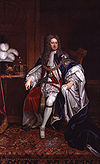 | 28 May 1660 Leineschloss son of Ernest Augustus, Elector of Brunswick-Lüneburg and Sophia of Hanover | Sophia Dorothea of Brunswick-Lueneburg-Celle 21 November 1682 2 children | 11 June 1727 Osnabrück aged 67 | Great-grandson of James VI and I |
| George II George Augustus 11 June 1727 – 25 October 1760 | 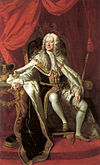 | 30 October 1683 Herrenhausen son of George I and Sophia Dorothea of Brunswick-Lueneburg-Celle | Caroline of Ansbach 22 August 1705 8 children | 25 October 1760 Kensington Palace aged 76 | Son of George I |
| George III George William Frederick 25 October 1760 – 29 January 1820 | 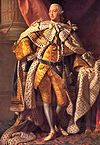 | 4 June 1738 Norfolk House son of Frederick, Prince of Wales andPrincess Augusta of Saxe-Gotha | Charlotte of Mecklenburg-Strelitz St James's Palace 8 September 1761 15 children | 29 January 1820 Windsor Castle aged 81 | Grandson of George II |
| George IV George Augustus Frederick 29 January 1820 – 26 June 1830 (Prince Regent since 1811) | 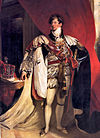 | 12 August 1762 St James's Palace son of George III and Charlotte of Mecklenburg-Strelitz | (1) Maria Anne Fitzherbert Park Lane 15 September 1785 (2) Caroline of Brunswick St James's Palace 8 April 1795 1 daughter | 26 June 1830 Windsor aged 67 | Son of George III |
| William IV William Henry 26 June 1830 – 20 June 1837 | 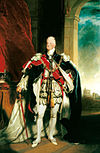 | 21 August 1765 Buckingham Palace son of George III and Charlotte of Mecklenburg-Strelitz | Adelaide of Saxe-Meiningen Kew Palace 13 July 1818 2 children | 20 June 1837 Windsor Castle aged 71 | Son of George III |
| Victoria Alexandrina Victoria 20 June 1837 – 22 January 1901 | 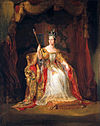 | 24 May 1819 Kensington Palace daughter of Prince Edward, Duke of Kent and Strathearn and Princess Victoria of Saxe-Coburg-Saalfeld | Albert of Saxe-Coburg and Gotha St James's Palace 10 February 1840 9 children | 22 January 1901 Osborne House aged 81 | Granddaughter of George III |
